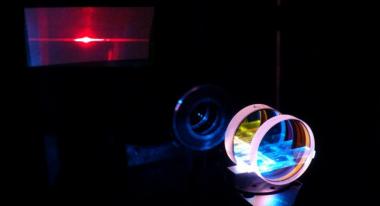

|
Solid state lasers operating in the visible range are promising candidates for a new generation of RGB (red, green, blue) colour displays because of their high brightness and low divergence compared to LEDs [1]. Trivalent Praseodymium ion has emissions in the blue (3P0 → 3H4), green (3P1 → 3H5), orange (3P0 → 3H6) and red (3P0 → 3F2) that makes it suitable for the aforementioned applications with the advantage that RGB colours can be obtained from the same single Pr3+ doped host in a compact and relatively easy way [2]. We have obtained the first room temperature, continuous wave laser operation in the red (639 nm) and orange (604 nm) spectral regions of Pr3+ doped LiYF4 planar waveguides fabricated by liquid phase epitaxy. Output powers of 25 mW and 12mW were achieved at 639 nm and 604 nm, respectively, by pumping with an optically pumped semiconductor laser (OPSL) operating at 479.2 nm |
Praseodynium-doped fluoride crystals are perfect materials for the realization of solid state lasers in the visible spectra because their low phonon energy avoids quenching of the 3P0 emitting level (weak multiphonon relaxation).
LiYF4 (YLF) layers (5mol%Gd:YLF) activated with 1.5mol%Pr3+ were grown onto undoped YLF substrates by Liquid Phase Epitaxy (LPE) in a vertical tubular furnace under controlled Ar and CF4 atmosphere [3]. The as grown layers were free of cracks and had mean thicknesses of about 80 µm. Gd3+ was introduced into the YLF host in order to (i) compensate for the lattice mismatch generated by the presence of Pr ions due to the ionic radii and (ii) increase the refractive index contrast of the layer with respect to that of the substrate for guiding purposes.
Spectroscopic characterization of the epitaxial layers comprised absorption and emission measurements. Their spectra did not differ significantly from that of a Pr:YLF bulk crystal, confirming good crystallization of the layers. The refractive indices of the substrate and the epilayers were measured by the prism-coupling technique at different wavelengths (M-lines method)*. In this way, a refractive index contrast of 2×10-3 was found, which is high enough to allow the epilayers (polished down to a thicknesses of 15 µm) to support up to three and four guided modes at the pump and the expected emission wavelengths, respectively. The propagation losses in our 9 mm-long planar waveguides were measured to be as high as 0.8±0.03 dB/cm at l = 632.8 nm.
*The M-lines method is a spectroscopic conventional characterization of optical waveguides, giving information on the index and the thickness of the deposited film. Depending on the angle of incidence of a laser beam, a minimum of reflected intensity is observed when one guided mode is excited (see R. Ulrich and R. Torge, Applied Optics, 12 (1973) 2901).
The laser cavity was formed by attaching the input and output mirrors to the end-faces of the waveguide by using an index matching gel (see figure 1(a)). A 0.28 NA microscope objective was used to couple the pump beam (OPSL) into the waveguide, whilst the emission signal was collimated with another objective (NA = 0.42) and measured with an optical spectrum analyzer. Figure 1(b) shows the output versus absorbed pump power corresponding to the to the laser operation of the LiY0.935Gd0.05Pr0.015F4 planar waveguide at the red laser wavelength of 639.4 nm for different transmissions of the output coupler mirror, OC. The highest output power, 25 mW was achieved with the 12% transmission OC the laser threshold was 381mW of absorbed pump power and the slope efficiency 6%. In the case of the orange guided laser (not shown here), the emission was found to be p polarized, centered at 604.2 nm (FWHM = 0.15 nm), with a maximum output power of 12mW, a laser threshold of 527mW of absorbed power and a slope efficiency of 5 % with respect to the absorbed pump power. These results suggest that by increasing the Pr3+ concentration into the layers and by reducing the propagation losses, it is expected to reach green laser oscillation and, more generally, a substantial improvement in the laser efficiencies. The realization of such an integrated and compact RGB waveguide laser based on these Pr:YLF epilayers is therefore envisaged in a near future.
References:
[1] U. Steegmüller, M. Kühnelt, H. Unold, T. Schwarz, R. Schulz, K. Auen, C. Walter, M. Schmitt, Proc. SPIE, 7001, 70010D (2008).
[2] Visible laser operation of Pr3+-doped fluoride crystals pumped by a 469 nm blue laser,
B. Xu, P. Camy, J-L Dualan, Z. Cay, R. Moncorgé, Opt. Express. 19, 1191 (2011).
[3] Tm:LiYF4 planar waveguide laser at 1.9 μm,
W. Bolaños, F. Starecki, A. Benayad, G. Brasse, V. Ménard, J.L. Doualan, A. Braud, R. Moncorgé, P. Camy, Opt. Lett. 37, 4032 (2012).
• Centre de Recherche sur les Ions, les Matériaux et la Photonique •  Institut Rayonnement Matière de Saclay
Institut Rayonnement Matière de Saclay














